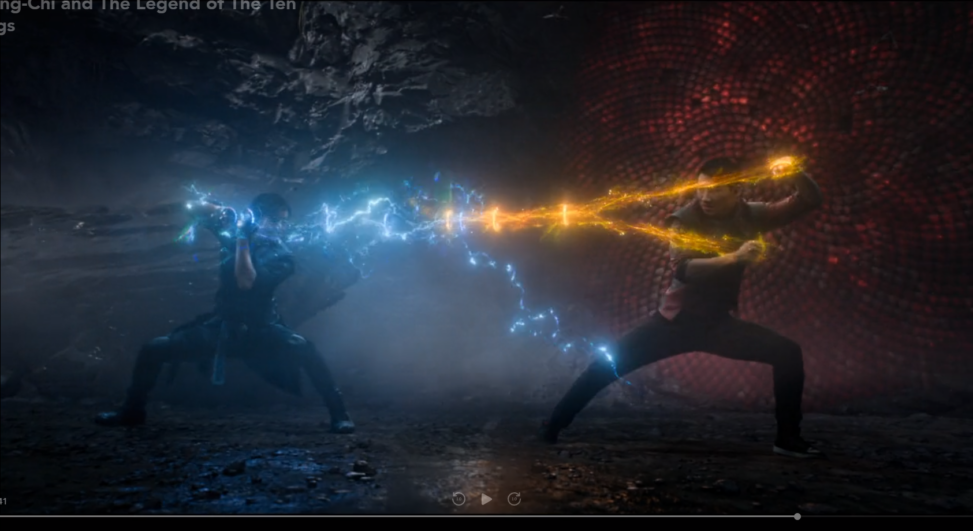Image Attribution: “Assignment 4, Part A – Kei Massalski” by Kei Massalski is licensed under CC0. (See interactive map)
Kei Massalski
Terryl Atkins
VISA 1500
November 26, 2021
Assignment 4, Part A
The scene I have chosen is from Marvel’s Shang-Chi and the Legend of the Ten Rings. It depicts the final confrontation between the film’s protagonist Shang-Chi and his father Xu Wenhu, the film’s antagonist. Shang-Chi is on the right hand side, highlighted by warm colour tones emitting from his powers, costume, and background, reflective of his role as the protagonist. Xu on the left hand side is shrouded in cold colour tones due to the same aspects as Shang-Chi, to provide contrast as the antagonist. The characters are framed in somewhat of a wide-shot, however Shang-Chi is posed to look larger than Xu, indicative of Shang-Chi’s character arc from novice to master. The characters are of East-Asian descent, and their stances, particularly Shang-Chi’s, is that of Chinese martial arts which is featured in nearly every action sequence in the movie. The action sequence is shot with a sweeping, coherent view of the action, as opposed to “shaky-cam” which many action films use, in order to provide the audience with a clear view of the action choreography between the two characters. The speed of the action is fast, but features no blood or gore. The two characters fight using magical rings as a weapon, yet with a clear martial arts influence on the choreography. The film grossed a total of $224 million domestically, and $431 million worldwide.
The film, with its showcase of Chinese martial arts and a nearly all-Asian cast, acts as a clear example of a recent push in the media, specifically Hollywood for more Asian representation in movies. Trends show that “the frequency of lead [Asian] roles increased over the last 25 years, with more diverse genres emerging in recent years” (Besana, Tiffany, et. al 1), largely due to the demand for racial representation in Western culture, and the growing appeal to Chinese markets from Hollywood enterprises. With China expanding on cinema infrastructure, combined with the world’s greatest population of 1.4 billion citizens, China holds immense power and potential regarding the success of a film’s gross (Song 1). As a result, studios in Hollywood, notably Disney, have been producing more films that feature Chinese characters and stories, such as Mulan (2020) and the upcoming Pixar film Turning Red (2022). While Disney’s primary goal may only be to gain a larger profit, the increasing prevalence of Asians cast into bigger roles has been seen as a positive change to Western media, since Asians were typically cast only to play stereotypes and caricatures as opposed to lead roles in major blockbusters. As someone of Asian descent myself, I believe exposing Western audiences to Asian cultures in a positive light without stereotyping is a welcome sight. However, it is clear Disney’s intentions are not to carry out social justice, but to increase profits, considering Disney gave special thanks to CCP authorities who oversaw “Re-education centers” of the Chinese Uighur population for allowing the use of filming locations in China in the end-credits of 2020’s Mulan.
Works Cited
Besana, Tiffany, et al. “Asian American Media Representation: A Film Analysis and Implications for Identity Development.” Research in Human Development, vol. 16, no. 3-4, 2019, pp. 201–225., doi:10.1080/15427609.2020.1711680.
Song, Xu. “Hollywood Movies and China: Analysis of Hollywood Globalization and Relationship Management in China’s Cinema Market.” Global Media and China, vol. 3, no. 3, 2018, pp. 177–194., doi:10.1177/2059436418805538.
